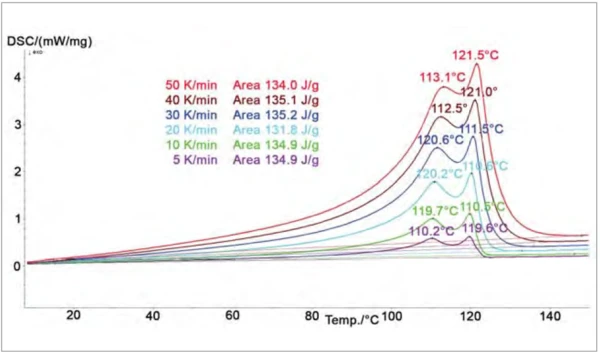Test Conditions
A multilayer containing different polyethylenes was measured with the DSC 214 Polyma at different heating rates from 5 K/min to 500 K/min between -20°C and 150°C. The sample was cooled at a controlled rate of 20 K/min between each heating in order to achieve the exact same thermal history at the beginning of each heating.
Test Results
The DSC curves are displaced in figures 1 and 2. The double peak detected in all segments of figure 1 (heating rate between 5 and 50 K/min) is related to the melting of polyethylenes.


As expected, the melting peak temperatures are shifted to higher values with increasing heating rates; i.e., the first peak determined at 110.2°C in the measurement at 5 K/min is shifted to 113.1°C for the measurement at 50 K/min (figure 1, violet and red curves). In addition, the effects are more pronounced in both height and width.
Figure 2 shows that the heating rate also influences the resolution of the peaks: separation is improved at lower heating rates. Whereas two well separated peaks can be evaluated in the measurements at 50 K/min or lower, the presence of the first component is only demonstrated by a shoulder in the curves for the measurements at 100 K/min and 200 K/min. At even higher heating rates (300, 400 and 500 K/min), only a single peak was detected. The NETZSCH Peak Separation Advanced Software was used to separate the two peaks detected in the measurement at 5 K/min. Figure 3 shows that the correlation between the measured double peak (dotted curve) and the overlapping of not two, but three different peaks with maxima at approx. 110°C (green curve), 115°C (blue curve) and 120°C (orange curve) is excellent. These three curves are most probably due to the melting of different polyethylene types.

Conclusion
The heating rate used in DSC influences the detected melting peaks in two ways: an increase in the heating rate magnifies the thermal effects, whereas a decrease in the heating rate yields a better separation of these effects. By using a low heating rate in combination with the NETZSCH Peak Separation software, the different components of a multilayer can be identified.